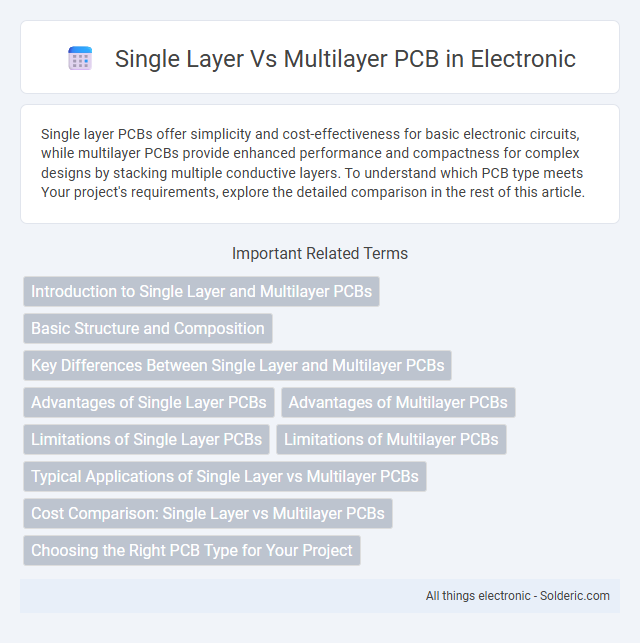Single layer PCBs offer simplicity and cost-effectiveness for basic electronic circuits, while multilayer PCBs provide enhanced performance and compactness for complex designs by stacking multiple conductive layers. To understand which PCB type meets Your project's requirements, explore the detailed comparison in the rest of this article.
Comparison Table
| Feature | Single Layer PCB | Multilayer PCB |
|---|---|---|
| Number of Layers | One conductive layer | Two or more conductive layers |
| Complexity | Simple circuit designs | Complex circuits with high density |
| Size | Larger board size for complex circuits | Compact size, saves space |
| Cost | Lower manufacturing cost | Higher production cost |
| Signal Integrity | Limited signal routing, more interference | Improved signal integrity and reduced EMI |
| Application | Simple electronics, basic devices | Advanced electronics, aerospace, medical |
| Reliability | Less reliable in complex setups | High reliability and durability |
Introduction to Single Layer and Multilayer PCBs
Single layer PCBs consist of a single conductive layer for circuit paths, making them ideal for simple, low-cost electronics with limited components. Multilayer PCBs have multiple conductive layers separated by insulating materials, allowing for complex, high-density circuits used in advanced electronics like computers and smartphones. Your choice between single layer and multilayer PCBs depends on the complexity, size, and performance requirements of your electronic device.
Basic Structure and Composition
Single layer PCBs consist of a single conductive copper layer laminated on a non-conductive substrate, typically fiberglass or epoxy resin, with component mounting on one side. Multilayer PCBs feature multiple copper layers separated by insulating layers, allowing complex circuit designs and increased component density within a compact form. The composition of multilayer PCBs includes alternating layers of copper and dielectric materials, bonded together using heat and pressure for enhanced electrical performance and signal integrity.
Key Differences Between Single Layer and Multilayer PCBs
Single layer PCBs consist of a single conductive copper layer on one side of the substrate, making them simpler and cost-effective for basic electronic circuits. Multilayer PCBs feature multiple copper layers separated by insulating materials, allowing for increased circuit density, enhanced performance, and miniaturization of complex devices. Your choice between single layer and multilayer PCBs depends on the design complexity, space constraints, and electrical requirements of your project.
Advantages of Single Layer PCBs
Single layer PCBs offer cost-effective manufacturing due to their simple design, making them ideal for low-complexity electronic devices. Their ease of production enables shorter lead times and reduces assembly errors, benefiting projects with tight deadlines and limited budgets. You can rely on single layer PCBs for consistent performance in applications with minimal circuit complexity, such as power supplies and basic sensors.
Advantages of Multilayer PCBs
Multilayer PCBs offer increased circuit density by stacking multiple layers of conductive material separated by insulating layers, enabling complex and compact designs. They improve signal integrity and electromagnetic interference (EMI) control through dedicated ground and power planes, enhancing overall device performance. Your designs benefit from enhanced reliability and reduced size, making multilayer PCBs ideal for advanced electronics requiring high-speed and high-density interconnections.
Limitations of Single Layer PCBs
Single layer PCBs face significant limitations in terms of circuit density and component complexity, restricting their use to simple electronic devices. They offer minimal routing space, which leads to increased board size or design constraints when integrating multiple components. Thermal management and electromagnetic interference are also less efficient compared to multilayer PCBs, making single layer boards unsuitable for high-performance applications.
Limitations of Multilayer PCBs
Multilayer PCBs face limitations such as increased manufacturing complexity and higher production costs compared to single layer PCBs. They demand precise layer alignment and advanced fabrication techniques, which can lead to longer lead times and potential for defects like delamination. Your design choices should consider these factors to balance complexity with reliability and budget constraints.
Typical Applications of Single Layer vs Multilayer PCBs
Single layer PCBs are commonly used in simple electronic devices such as power supplies, LED lighting, and basic consumer electronics due to their cost-effectiveness and straightforward design. Multilayer PCBs find typical applications in complex devices like smartphones, medical equipment, aerospace systems, and high-speed computing, where space optimization and high-density circuit integration are critical. The choice between single layer and multilayer PCBs hinges on device complexity, performance requirements, and available space.
Cost Comparison: Single Layer vs Multilayer PCBs
Single layer PCBs are generally more cost-effective than multilayer PCBs due to simpler manufacturing processes and fewer materials required. Multilayer PCBs involve additional layers of conductive material and insulating substrates, increasing production complexity and expenses. Your project budget can benefit from choosing single layer PCBs when circuit design and functionality demands are minimal, while multilayer PCBs are justified for advanced electronic applications requiring compact size and improved performance despite higher costs.
Choosing the Right PCB Type for Your Project
Single layer PCBs offer simplicity and cost-effectiveness for basic circuits with limited components, making them ideal for straightforward projects. Multilayer PCBs provide enhanced electrical performance, higher component density, and improved signal integrity, suitable for complex or high-frequency applications. Choosing the right PCB type for your project depends on factors like circuit complexity, space constraints, and budget considerations.
single layer vs multilayer PCB Infographic

 solderic.com
solderic.com